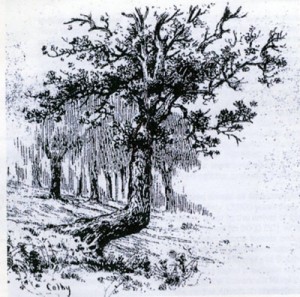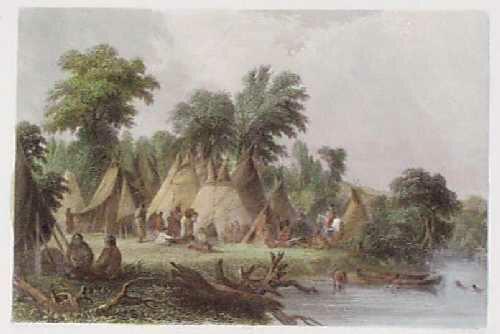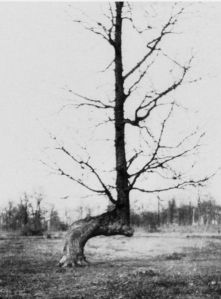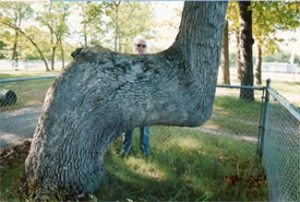Most Americans are Romantics when it comes to Indians. A large number of people will tell you that they have a Native American ancestor, although this is mostly the stuff of myth.
I remember interviewing 99-year-old Sister Suzanne Helmin at the monastery before she died. She was born in 1912 and grew up the first child in her family not to live in a log cabin. Her grandparents lived nearby and her mother said that early in her marriage she would walk through woods between her house and her mother-in-law’s house and see Indians. They camped at various spots around there. This seemed as mysterious and wonderful to Suzanne as it does to me.
Last week Steve was working on a property out on Kriegel Lake, one of the small lakes in this area. The guy who lives there has moved an old streetcar from St. Paul up to the lake and turned it into a house. While they were planting trees, he pointed down the shore and said, “What do you think of my oak tree?”
The oak is bent near the base, stretches out across the lake and then suddenly makes a 90 degree turn and goes straight up. It is a crazy tree.
Steve works with a guy, Jeff, who seems to know everything there is to know about plants and trees. We have yet to find a plant he can’t identify on the spot (he is always right), and as Steve says, he can “read” the landscape, pointing out signs of different things that have happened to the land, types of vegetation and cultivation.
“That looks like an Indian Marker tree,” Jeff said. Neither Steve nor the home-owner had ever heard of that before.
 It seems the Native Americans used to bend and stake trees to mark trails and campsites. They are all over the place, giant trees that were bent over when young, staked until they healed and then allowed to grow back up. An internet search shows they are prevalent in the Great Lakes region, with a number of them documented in Illinois, Wisconsin, and Michigan by a researcher named Dennis Downes (who may have even trademarked the name).
It seems the Native Americans used to bend and stake trees to mark trails and campsites. They are all over the place, giant trees that were bent over when young, staked until they healed and then allowed to grow back up. An internet search shows they are prevalent in the Great Lakes region, with a number of them documented in Illinois, Wisconsin, and Michigan by a researcher named Dennis Downes (who may have even trademarked the name).
Of course, there is also controversy. What is just a damaged tree– a lightning strike, or a place where a tree fell on a sapling and shaped it, then decomposed over time, releasing it?– and what is evidence of Ojibway or Pottawattamie trail marking? There is no question that these trees exist, just a question of their number. And meanwhile in Highland Park and Glencoe and other suburbs of Chicago, trees are getting plaques and being protected.
The homeowner on Kriegel Lake said that he thought Indians had been on that land– it had that spiritual energy. I don’t really know what that means. In a nation where Native Americans make up less than 2 percent of the population, we like to imagine the time– an unspoiled time before the genocide– when they were everywhere. We have folded them in with our idea of the sacred with regards to the land. A sacredness we fear is lost or don’t feel we are up to ourselves, we children of the suburban and urban landscapes. We want to live there.
Jeff is part Native American, though you wouldn’t know it to meet him casually. He has some great stories about his family. He works long shifts as a mechanic at the chicken processing plant and spends all other available time restoring prairies, busting buckthorn, pruning trees, and reading the landscape and telling us its stories.
photos from: http://www.printsoldandrare.com/indians/index.html; http://www.greatlakestrailtreesociety.org/trail_tree_gallery.html; and http://en.wikipedia.org/wiki/Trail_trees




Loved this! Your research didn’t say anything about Marker Trees being in WA State? In Eastern WA or in the mountains the trees definitely would be affected by heavy snows, but where I live not so much. There are definitely trees shaped like this extending over the Sound and even on our lake! Thanks for putting a new observation on my radar.
I am sure they are everywhere. The guy who did the research that I found seems to be based in Wisconsin and so is focused on this area. I was surprised there were so many in Illinois, even in the Chicago suburbs!
It’s ashame that the area we grew up in didn’t have more historical markers and the history of the local land wasn’t part of our education. That was always a blessing where ever we lived that we could include local history into our homeschool curriculum. Growing up I had never connected Illinois with Native Americans?! Crazy. The PNW is loaded to overflowing with historical markers and local history info.
I grew up on property that had two Indian trail marker trees on it. They were in sight of each other and pointed the way to Snoqualamie Pass. The property is in Woodway Park, south of Edmonds, Washington. We found a child’s copper bracelet near one of the trees. Recently while in a community park in Anacortes I found two more trees that both pointed the same direction, not in sight of each other, but remarkably the same direction on my compass. I’m going back to bushwack around and find more.
Anyone else have nay information on these tress in Anacortes WA?
Thanks for posting this, Barb. Definitely confirmation of multiple trails to the same place. Do you know what they were pointing to?
I think they are pointing to a safer way to get to the Staits of Juan De Fuca and out to the Pacific Ocean instead of to Deception Pass where currents reach 5 to 6 knots at peak tidal changes. Even large boats have trouble navigating thru there. They may be directing trail users to a safer harbor and beach sheltered by another island. I really don’t know, just speculating, but they definitely point in the same direction.
That is really cool!
I live in northern Texas and we have several trees that have been confirmed by the Comanche Nation to be Comanche Marker Trees. There are others that have not been “confirmed” by the Comanche, but may be Indian marker trees of a different tribe. It is very fascinating and every effort is being made to identify and recognize these trees before they are lost due to failure or development of the land.
thanks for visiting the blog and posting, RuthAnn. It is an interesting feature of the American landscape and seems to be in every region.
Love this discussion! I lived in Northern Illinois and saw these trees close to rural roads which were old trails. Now that I live in Eastern Washington state I wonder if there is any documentation about these trees here and where they are.